Qianrui Zhou
MIntRec2.0: A Large-scale Benchmark Dataset for Multimodal Intent Recognition and Out-of-scope Detection in Conversations
Mar 20, 2024Abstract:Multimodal intent recognition poses significant challenges, requiring the incorporation of non-verbal modalities from real-world contexts to enhance the comprehension of human intentions. Existing benchmark datasets are limited in scale and suffer from difficulties in handling out-of-scope samples that arise in multi-turn conversational interactions. We introduce MIntRec2.0, a large-scale benchmark dataset for multimodal intent recognition in multi-party conversations. It contains 1,245 dialogues with 15,040 samples, each annotated within a new intent taxonomy of 30 fine-grained classes. Besides 9,304 in-scope samples, it also includes 5,736 out-of-scope samples appearing in multi-turn contexts, which naturally occur in real-world scenarios. Furthermore, we provide comprehensive information on the speakers in each utterance, enriching its utility for multi-party conversational research. We establish a general framework supporting the organization of single-turn and multi-turn dialogue data, modality feature extraction, multimodal fusion, as well as in-scope classification and out-of-scope detection. Evaluation benchmarks are built using classic multimodal fusion methods, ChatGPT, and human evaluators. While existing methods incorporating nonverbal information yield improvements, effectively leveraging context information and detecting out-of-scope samples remains a substantial challenge. Notably, large language models exhibit a significant performance gap compared to humans, highlighting the limitations of machine learning methods in the cognitive intent understanding task. We believe that MIntRec2.0 will serve as a valuable resource, providing a pioneering foundation for research in human-machine conversational interactions, and significantly facilitating related applications. The full dataset and codes are available at https://github.com/thuiar/MIntRec2.0.
Token-Level Contrastive Learning with Modality-Aware Prompting for Multimodal Intent Recognition
Dec 22, 2023Abstract:Multimodal intent recognition aims to leverage diverse modalities such as expressions, body movements and tone of speech to comprehend user's intent, constituting a critical task for understanding human language and behavior in real-world multimodal scenarios. Nevertheless, the majority of existing methods ignore potential correlations among different modalities and own limitations in effectively learning semantic features from nonverbal modalities. In this paper, we introduce a token-level contrastive learning method with modality-aware prompting (TCL-MAP) to address the above challenges. To establish an optimal multimodal semantic environment for text modality, we develop a modality-aware prompting module (MAP), which effectively aligns and fuses features from text, video and audio modalities with similarity-based modality alignment and cross-modality attention mechanism. Based on the modality-aware prompt and ground truth labels, the proposed token-level contrastive learning framework (TCL) constructs augmented samples and employs NT-Xent loss on the label token. Specifically, TCL capitalizes on the optimal textual semantic insights derived from intent labels to guide the learning processes of other modalities in return. Extensive experiments show that our method achieves remarkable improvements compared to state-of-the-art methods. Additionally, ablation analyses demonstrate the superiority of the modality-aware prompt over the handcrafted prompt, which holds substantial significance for multimodal prompt learning. The codes are released at https://github.com/thuiar/TCL-MAP.
MIntRec: A New Dataset for Multimodal Intent Recognition
Sep 09, 2022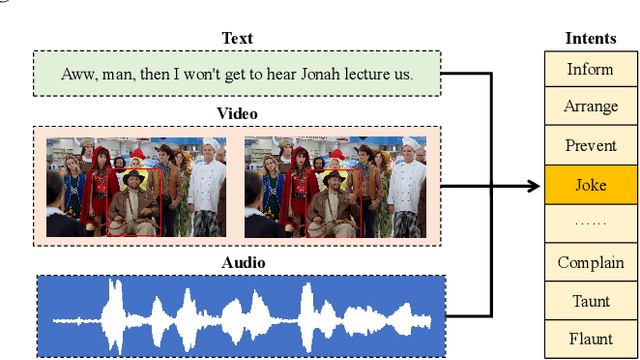

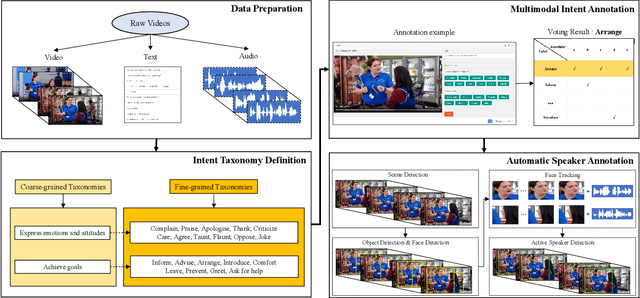

Abstract:Multimodal intent recognition is a significant task for understanding human language in real-world multimodal scenes. Most existing intent recognition methods have limitations in leveraging the multimodal information due to the restrictions of the benchmark datasets with only text information. This paper introduces a novel dataset for multimodal intent recognition (MIntRec) to address this issue. It formulates coarse-grained and fine-grained intent taxonomies based on the data collected from the TV series Superstore. The dataset consists of 2,224 high-quality samples with text, video, and audio modalities and has multimodal annotations among twenty intent categories. Furthermore, we provide annotated bounding boxes of speakers in each video segment and achieve an automatic process for speaker annotation. MIntRec is helpful for researchers to mine relationships between different modalities to enhance the capability of intent recognition. We extract features from each modality and model cross-modal interactions by adapting three powerful multimodal fusion methods to build baselines. Extensive experiments show that employing the non-verbal modalities achieves substantial improvements compared with the text-only modality, demonstrating the effectiveness of using multimodal information for intent recognition. The gap between the best-performing methods and humans indicates the challenge and importance of this task for the community. The full dataset and codes are available for use at https://github.com/thuiar/MIntRec.
Towards Open Intent Detection
Mar 11, 2022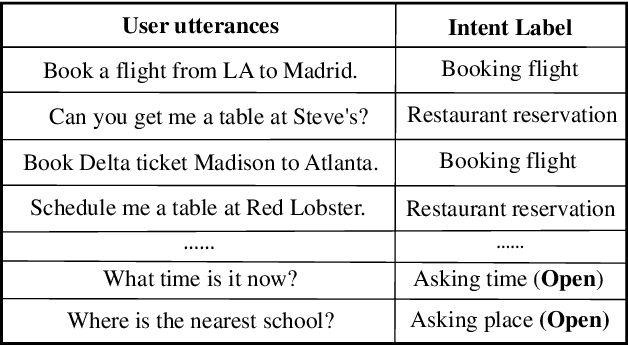

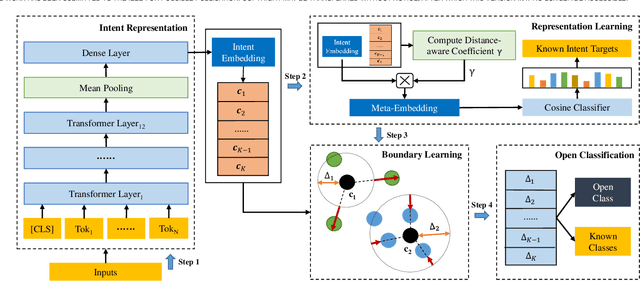

Abstract:The open intent detection problem is presented in this paper, which aims to identify known intents and detect open intent in natural language understanding. Current methods have two core challenges. On the one hand, the existing methods have limitations in learning robust representations to detect the open intent without any prior knowledge. On the other hand, there lacks an effective approach to learning the specific and compact decision boundary to distinguish the known intents and the open intent. This paper introduces an original pipeline framework, DA-ADB, to address these issues, which successively learns discriminative intent features with distance-aware strategy and appropriate decision boundaries adaptive to the feature space for open intent detection. The proposed method first leverages distance information to enhance the distinguishing capability of the intent representations. Then, it obtains discriminative decision boundaries adaptive to the known intent feature space by balancing both the empirical and open space risks. Extensive experiments show the effectiveness of distance-aware and boundary learning strategies. Compared with the state-of-the-art methods, our method achieves substantial improvements on three benchmark intent datasets. It also yields robust performance with different proportions of labeled data and known categories.
OpenAttack: An Open-source Textual Adversarial Attack Toolkit
Sep 19, 2020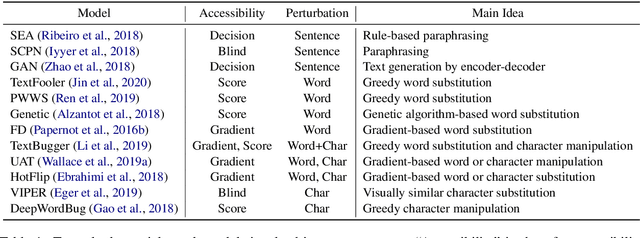
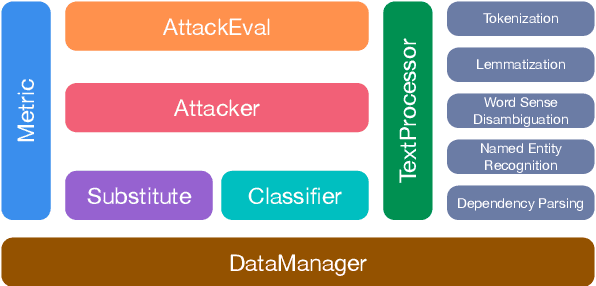
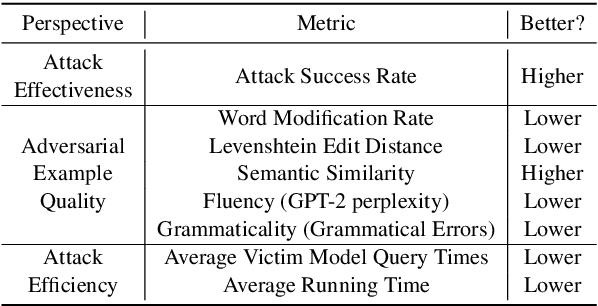
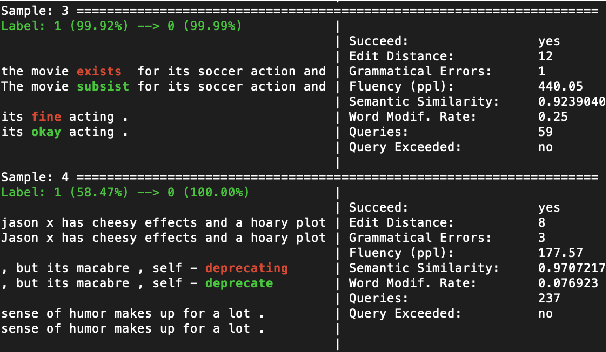
Abstract:Textual adversarial attacking has received wide and increasing attention in recent years. Various attack models have been proposed, which are enormously distinct and implemented with different programming frameworks and settings. These facts hinder quick utilization and apt comparison of attack models. In this paper, we present an open-source textual adversarial attack toolkit named OpenAttack. It currently builds in 12 typical attack models that cover all the attack types. Its highly inclusive modular design not only supports quick utilization of existing attack models, but also enables great flexibility and extensibility. OpenAttack has broad uses including comparing and evaluating attack models, measuring robustness of a victim model, assisting in developing new attack models, and adversarial training. Source code, built-in models and documentation can be obtained at https://github.com/thunlp/OpenAttack.
 Add to Chrome
Add to Chrome Add to Firefox
Add to Firefox Add to Edge
Add to Edge